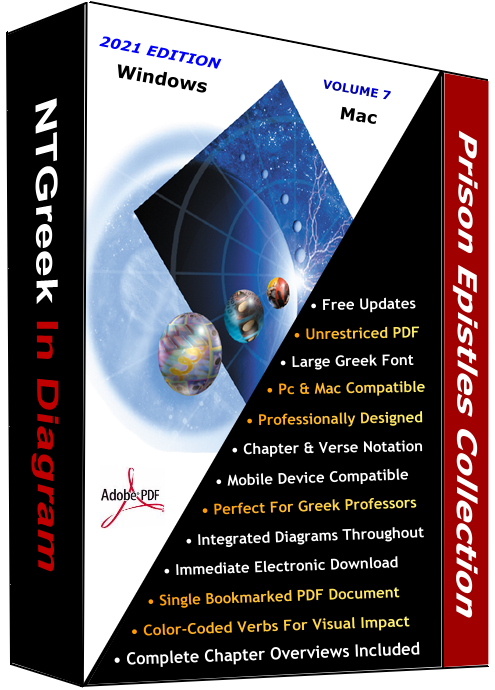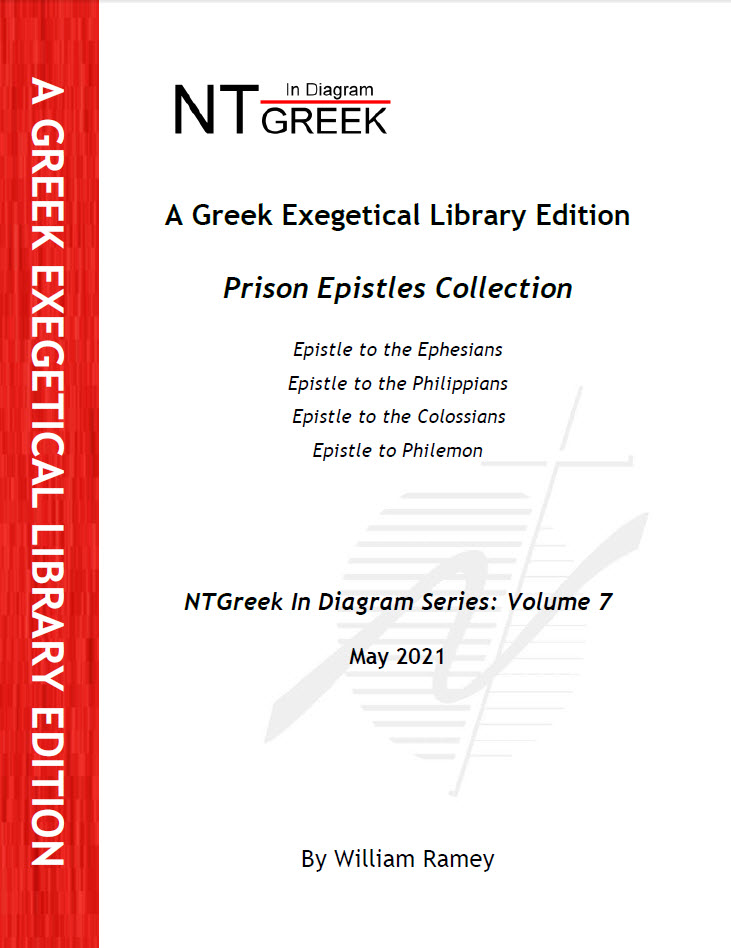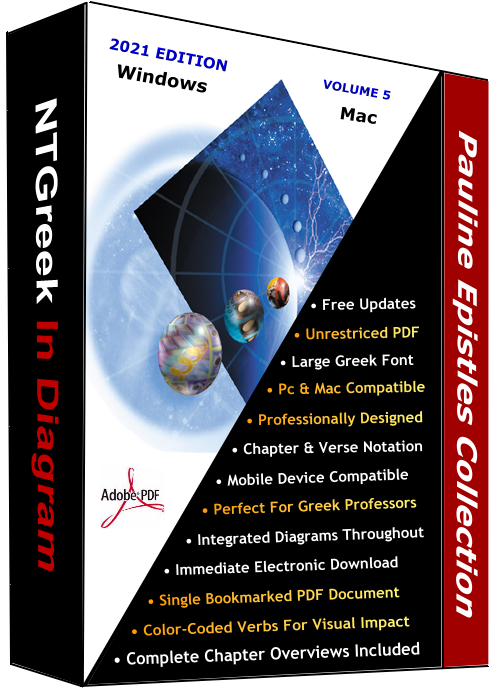

Title:
Prison Epistles CollectionSeries:
NTGreek In Diagram: Volume 6Edition:
2021Last Update:
May 2021ISBN-10:
1939762146ISBN-13:
978-1-939762-14-6Language:
Greek diagrams with English commentsFormat:
Electronic downloadable PDF bookmarked documentLength:
426 pages (including overviews and notes)Price:
$9.95 USDFrom a Roman prison or while under house arrest, apostle Paul wrote words of encouragement and instruction in letters to three different assemblies throughout the Roman Empire and one letter to an individual. Whereas he may have been fettered and shackled to a series of Roman guards, Paul's inspired words remain unfettered and free. This collection contains a comprehensive set of diagrams for Ephesians, Philippians, Colossians, and Philemon.
Ephesians exhibits long and complex sentence constructions, such as is not found anywhere else among Paul's epistles (cf. 1:3-14; 15-23; 2:1-7, 11-13, 14-18, 19-22; 3:1-19; 4:1-6, 11-16, 17-19, 20-24; 6:14-20). The language of the letter has a strong Semitic flavor because of the accumulation of synonyms and genitival constructions. The language and style demonstrates striking similarities to the Qumran literature. Semitic syntactic appearances occur four times more frequently in this short epistle than all other Paul's letters.
Paul's relationship with those in Philippi was particularly warm, even though he remained in the city only a short time. The Philippians had sent financial assistance to him while he was in Thessalonica on at least two occasions. The Epistle to the Philippians in part is a response to an additional gift from them. Seventeen times, Paul uses the words "joy" and "rejoice" in this short letter. Certainly, these words arise because of the Philippians' participation in the Gospel with Paul; but more so because of Paul's joy irrespective of circumstances and the joy he would kindle in his readers.
Epistle to the Philippians a delightful letter, perfect to study Paul's logic and rhetorical style. His word order within sentences is remarkably flexible which goes beyond clause order. In some instances, Paul employs extraordinary syntax to express his inner heart-felt warmth toward those whom he cherished.
Probably the purpose of Epaphras' visit to Paul on behalf of those in Colossae was to seek his advice as to how deal with the false teaching which had arisen, and if allowed to continue unchecked, it would grievously threaten the stability of the local assembly. Paul crushes the basis for this heretical teaching in the Epistle to the Colossians.
The shortest letter of all Paul's letters is the Epistle to Philemon. It fits the genre of the Greco-Roman era which there are many examples among the papyri. The letter's purpose is to encourage Philemon to welcome his runaway slave as if he were Paul himself. The body of the epistle (vv. 4-22) follows the Greco-Roman art of persuasion. Paul's frequent word-plays aid to set the tone of his letter to Philemon, all of which makes it a delightful letter to study in Greek.
The Epistle to Philemon is a delicate yet one of Paul's most forceful appeals found in any of his other letters. Paul urges Philemon to receive Onesimus as himself. Apparently, Onesimus had some specific skills, valuable not only to Philemon, but also to Paul. Paul writes in verse 11, "Formerly he was useless to you, but now he has become useful both to you and to me." While the pun (Onesimus means "useful") has often been noted, the nature of Onesimus' real usefulness to Paul has not been explored, of which I leave to the reader to do so.
The Prison Epistles Collection is also part of the NTGreek In Diagram's Master Diagram, Master Diagram Upgrade, and Pauline Epistles Collections. Every Collection includes all diagrams in a single convenient bookmarked PDF document that makes navigation incredibly easy.
If you are a Greek professor or instructor and desire more information about group discounts, please contact me. Several Greek professors and instructors encourage their students to purchase the diagrams and use them as part of the class curriculum.
The following screen shots are representative pages from the Prison Epistles Collection. The purchased diagram collection includes all the diagrams. Click on any thumbnail to view its larger image.

 Cover Page
Cover Page Title Page
Title Page Eph 1:13-14
Eph 1:13-14 Eph 2:1-2
Eph 2:1-2 Eph 2:13-15a
Eph 2:13-15a Eph 3:6-7
Eph 3:6-7 Eph 3:20-21
Eph 3:20-21 Eph 4:14-15
Eph 4:14-15 Eph 4:20-24
Eph 4:20-24 Eph 5:1-4
Eph 5:1-4 Eph 5:12-14
Eph 5:12-14 Eph 6:1-4
Eph 6:1-4 Eph 6:21-22
Eph 6:21-22 Phil 1:4-6
Phil 1:4-6 Phil 1:25-27a
Phil 1:25-27a Phil 2:12-13
Phil 2:12-13 Phil 2:22-24
Phil 2:22-24 Phil 3:4b-7
Phil 3:4b-7 Phil 3:13-15
Phil 3:13-15 Phil 4:10-11
Phil 4:10-11 Col 1:3-5
Col 1:3-5 Col 1:13-15
Col 1:13-15 Col 2:8-10
Col 2:8-10 Col 3:13-15
Col 3:13-15 Col 4:2-4
Col 4:2-4 Phlm 8-11
Phlm 8-11 Col 1:1 Note
Col 1:1 Note Col 1:22 Note
Col 1:22 Note Col 2:4 Note
Col 2:4 Note Col 2:18 Note
Col 2:18 Note Col 3:1 Note
Col 3:1 Note Col 3:13 Note
Col 3:13 Note Col 4:5 Note
Col 4:5 Note Col 4:17 Note
Col 4:17 Note Phlm 4 Note
Phlm 4 Note Phlm 16 Note
Phlm 16 Note
